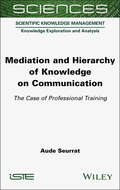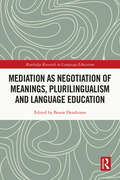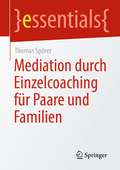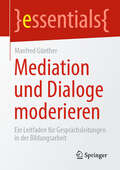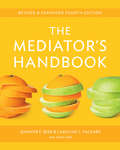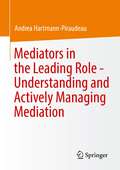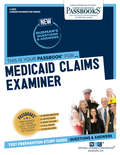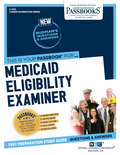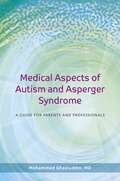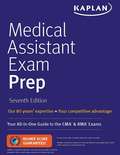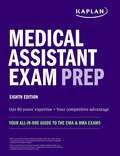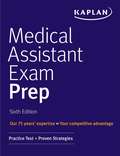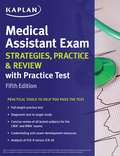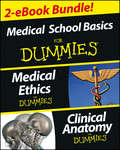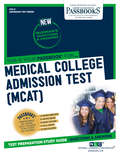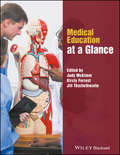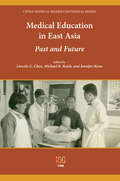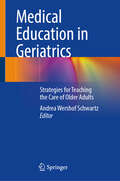- Table View
- List View
Mediation and Hierarchy of Knowledge on Communication: The Case of Professional Training (ISTE Consignment)
by Aude SeurratThis book explores the various forms of knowledge selection and mediation concerning communication in organizations, particularly focusing on professional communication training courses. The work is based on a corpus study of training catalogues, an interview survey of trainers, as well as ethnographic observations of professional communication training courses. Mediation and Hierarchy of Knowledge on Communication analyzes how the pursuit of certainty contributes to favoring certain types of 'learned' knowledge over others. This analysis reveals that the theoretical frameworks employed in vocational training for communicators predominantly rely on experimental reasoning and explanatory models, drawing upon insights from psychosocial experiments, neuroscience and management science. This quest for certainty has positioned the life sciences as the benchmark for scientific validity, resulting in a form of biologization of communication that this book aims to deconstruct.
Mediation as Negotiation of Meanings, Plurilingualism and Language Education (Routledge Research in Language Education)
by Bessie DendrinosBringing together the voices of a diverse group of scholars and language professionals, this edited collection, concerned with the cultivation of plurilingualism in multilingual educational settings, builds on the theory and practice of linguistic and cultural mediation both as curricular content and social practice.The chapters view mediation as an important aspect of communication which involves dynamic, purposeful interactivity, implicating social agents in the negotiation and construction of socially situated meanings across different languages and within the same language. Theoretically informed chapters present views on mediation as well as contributors’ research and project outcomes in educational interventions. They also describe how mediation has been incorporated in educational practices and how it materialises in social contexts. Ultimately, this book makes the case for why mediation constitutes a key competence to be developed for active global and local citizenry in today’s societies where there is an increased rate of knowledge acquisition and exchange.Presenting research from classrooms and other multilingual environments, this book offers concrete suggestions for the development of language users/learners’ ability to mediate within and across languages. It will appeal to scholars, researchers and postgraduate students in the fields of language and education, education policy and politics, bilingualism and plurilingualism more generally. Curriculum designers may also find the volume of use.
Mediation der Zukunft für Paare und Familien (essentials)
by Thomas SpörerDer status quo der Mediation in Deutschland charakterisiert einen Zustand, der dieser Konfliktbearbeitungsform, gemessen am Bedarf, immer noch eine marginale Rolle zuschreibt. Die Gegenüberstellung einer juristischen Bearbeitung und ihrem non-juristischen Gegenpart unterstreicht zwar die Differenzen in der Vorgehensweise, blendet aber eine vorherrschende Gemeinsamkeit der beiden Systeme aus, die erst deutlich wird, wenn die Sicht darauf aus dem Blickwinkel der Betroffenen fällt. Dieser Beitrag betrachtet speziell Mediation aus der Bedürfnislage der Klientel heraus und fragt danach, wie sich diese Methode verändern muss, wenn sie den Bedürfnissen ihre Betroffenen gerecht werden möchte.
Mediation durch Einzelcoaching für Paare und Familien (essentials)
by Thomas SpörerEin Lehrsatz der Familienmediation betont die Fähigkeit des Individuums zu einer Lösungsfindung bezügl. der eigenen Angelegenheiten. Diese setzen sich zusammen aus eigenen Erfahrungen, Einschätzungen, Hoffnungen, Befürchtungen wie auch zukünftigen Aussichten. Subjektive Bedürfnisse sind somit in Einzelgesprächen bestmöglich recherchierbar und bearbeitbar. Von daher braucht Mediation außer dem Dreiergespräch speziell auch Elemente des Einzelcoachings zur Erarbeitung von einigungsrelevanten Gesprächsanteilen. Dieser Band unterstreicht die Bedeutung von Coachingelementen in der Mediation und beleuchtet außerdem die Zukunftsgestaltung als integralen Bestandteil der Mediationsarbeit über das rechtswirksame Scheidungsurteil hinaus.
Mediation und Dialoge moderieren: Ein Leitfaden für Gesprächsleitungen in der Bildungsarbeit (essentials)
by Manfred GüntherLehrkräfte in der Erwachsenenbildung oder an Schulen sollen erfahren, wie in unterschiedlichsten Settings eine professionelle Gesprächsleitung gestaltet werden kann. Auch Sonderformen wie Kollegiale Teamberatung oder Dialoge werden vorgestellt. Zur Ausgestaltung der Gesprächsrunden werden paradoxe Interventionen, Brainstorms, Mindmaps u.v.a. gezeigt - auch Schlichtungsgespräche und der TOA. Hinzu kommen außergewöhnliche Arbeitsformen wie Streitbarer bzw. Deliberativer Dialog. Eine Liste der Einsatzgebiete und 4 Praxisbeispiele dienen der Anschaulichkeit. Der Text endet mit Infos zur Online-Moderation sowie zum IT- Einsatz.
Mediatoren in der Hauptrolle – Mediation verstehen und aktiv steuern
by Andrea Hartmann-PiraudeauDieses Buch richtet sich an Leser, die sich mit dem Thema Mediation, Verhandlung und anderen Methoden zur Konfliktklärung beschäftigen. Der Einsatz von Mediation ist weit verbreitet, die Erforschung seiner Wirkung jedoch steckt noch in den Anfängen. Wenn Mediation eine Möglichkeit der Klärung von Konflikten unserer Zeit ist, dann tragen Mediatoren eine Verantwortung: Im Kleinen, bei der Klärung der akuten Konflikte, und im Großen, bei der Gestaltung und Etablierung einer neuen Form des gesellschaftlichen Dialogs. Sie sollten wissen, was sie tun. Sie sollten wissen, welche Interventionen sie wann einsetzen und welche Wirkung diese haben. Dieses Buch hilft mit seinen Forschungsergebnissen das relevante Feld der Mediation durch wissenschaftliche Erkenntnisse zu stärken und Handlungsempfehlung für Mediatoren aus den Ergebnissen abzuleiten.
The Mediator's Handbook
by Caroline C. Packard Eileen Stief Jennifer E. BeerThe popular The Mediator's Handbook presents a time-tested, adaptable model for helping people work through conflict. Extensively revised to incorporate recent practice and thinking, the accessible manual format lays out a clear structure for new and occasional mediators while offering a detailed, nuanced resource for professionals. Starting with a new chapter on assessing conflict and bringing people to the table, the first section explains the process step by step, from opening conversations and exploring the situation through the phases of finding resolution--deciding on topics, reviewing options, and testing agreements. The "Toolbox" section details the concepts and skills a mediator needs in order to: Understand the conflict Support the people Facilitate the process Guide decision-making Throughout the book, the emphasis is on what the mediator can do or say now, and on the underlying principles and core methods that can help the mediator make wise choices. Long a popular course textbook for high schools, universities, and training programs, The Mediator's Handbook is also a valued desk reference for professional mediators and a practical guide for managers, organizers, teachers, and anyone working with clients, customers, volunteers, committees, or teams. Jennifer E. Beer, PhD, mediates organizational conflicts, facilitates meetings, and offers related workshops, regularly teaching a negotiation course at Wharton (University of Pennsylvania). Caroline C. Packard, JD led Friends Conflict Resolution Programs for fifteen years and is an organizational conflict response specialist and mediator based in Philadelphia, Pennsylvania. Eileen Stief developed the mediation process presented in the Handbook, training a generation of mediators to work with community, multi-party, and environmental disputes.
Mediators in the Leading Role - Understanding and Actively Managing Mediation
by Andrea Hartmann-PiraudeauThis book is intended for readers interested in mediation, negotiation, and other methods of conflict resolution. The use of mediation is widespread, but research into its impact is still in its infancy. If mediation is a way of resolving conflicts of our time, then mediators have a responsibility: on a small scale, in resolving acute conflicts, and on a large scale, in shaping and establishing a new form of social dialogue. They should know what they are doing. They should know which interventions to use and when, and what effect they have. With its research results, this book helps to strengthen the relevant field of mediation through scientific findings and to derive recommendations for action for mediators from the results.This book is a translation of the original German 1st edition Mediatoren in der Hauptrolle – Mediation verstehen und aktiv steuern by Andrea Hartmann-Piraudeau, published by Springer Fachmedien Wiesbaden GmbH, part of Springer Nature in 2020. The translation was done with the help of artificial intelligence (machine translation by the service DeepL.com). A subsequent human revision was done primarily in terms of content, so that the book will read stylistically differently from a conventional translation. Springer Nature works continuously to further the development of tools for the production of books and on the related technologies to support the authors.
Medicaid Claims Examiner: Passbooks Study Guide (Career Examination Series)
by National Learning CorporationThe Medicaid Claims Examiner Passbook® prepares you for your test by allowing you to take practice exams in the subjects you need to study. It provides hundreds of questions and answers in the areas that will likely be covered on your upcoming exam, including but not limited to: Interviewing claimants; Medical terminology; Understanding and interpreting written material; Documents and forms; Preparing written materials; Supervision; and more.
Medicaid Eligibility Examiner: Passbooks Study Guide (Career Examination Series)
by National Learning CorporationThe Medicaid Eligibility Examiner Passbook® prepares you for your test by allowing you to take practice exams in the subjects you need to study. It provides hundreds of questions and answers in the areas that will likely be covered on your upcoming exam, including but not limited to: name and number checking; public contact principles and practices; office record keeping; coding/decoding information; and more.
Medical Aide: Passbooks Study Guide (Career Examination Series #C-1364)
by National Learning CorporationThe Medical Aide Passbook® prepares you for your test by allowing you to take practice exams in the subjects you need to study. It provides hundreds of questions and answers in the areas that will likely be covered on your upcoming exam, including but not limited to: preparing written material; medical terminology; office record keeping; understanding and interpreting written material; and more.
Medical Aspects of Autism and Asperger Syndrome: A Guide for Parents and Professionals
by Mohammad GhaziuddinPeople with autism are at a higher risk of having additional medical conditions, so increased care should be taken to ensure any other needs are detected early and effectively managed. This book is the perfect aid for doing so, providing detailed information on the range of possible further conditions, including epilepsy, eating disorders or genetic conditions. Written for both parents and practitioners, including students, it shows how these medical conditions can be identified, and explains the range of possible treatments that are available that may improve the quality of life of the affected person.
Medical Assistant Exam Prep: Your All-in-One Guide to the CMA & RMA Exams
by Kaplan NursingKaplan's Medical Assistant Exam Prep provides the in-depth content, comprehensive review, and targeted practice you need to pass the Certified Medical Assistant and Registered Medical Assistant exams. Whether you're a first-time test taker or you're studying for recertification, Kaplan's up-to-date content and proven test-taking strategies will help you face the exam with confidence.Comprehensive ReviewReview of all tested subjects for the CMA and RMA examsDiagnostic test to help you target areas for score improvement and make the most of your study timeFull-length practice test with 300 questionsEnd-of-chapter quizzes with detailed answer explanationsCase study–based practice questions to develop your critical thinking skillsNew discussions including: the medical assistant&’s role in emergency preparedness and the Patient-Centered Medical Home (PCMH) model of careUpdated discussions including: electronic health records (EHRs), personal health records (PHRs), and patient rights; guidelines for reporting healthcare data breaches; billing procedures; and day-to-day electronic communications in the medical officeExpert GuidanceExpert advice on building and maintaining professional credentialsUpdated career resources and a guide to the certification processWe invented test prep—Kaplan (www.kaptest.com) has been helping students for almost 80 years. Our proven strategies have helped legions of students achieve their dreams.
Medical Assistant Exam Prep: Your All-in-One Guide to the CMA & RMA Exams (Kaplan Test Prep)
by Kaplan NursingKaplan's Medical Assistant Exam Prep provides the in-depth content, comprehensive review, and targeted practice you need to pass the Certified Medical Assistant and Registered Medical Assistant exams. Whether you're a first-time test taker or you're studying for recertification, Kaplan's up-to-date content and proven test-taking strategies will help you face the exam with confidence. Kaplan is so certain that Medical Assistant Exam Prep offers all the knowledge you need to pass the exam that we guarantee it: After studying with the book, you'll score higher on your medical assistant exam—or you'll get your money back.Comprehensive ReviewReview of all tested subjects for the Certified Medical Assistant (CMA) and Registered Medical Assistant (RMA) examsDiagnostic test to help you target areas for score improvement and make the most of your study timeFull-length practice test with 300 questionsEnd-of-chapter quizzes with detailed answer explanationsCase study–based practice questions to develop your critical thinking skills, now with 2 NEW case studies!Updated professional resources with advice for building an electronic portfolioNew discussions including: Covid-19, pediatric vaccinations, telehealthNew back-of-book Reference Guide with quick facts at your fingertips: normal vital signs, EKG leads & interpretation, order of draw, and moreExpert GuidanceExpert advice on building and maintaining professional credentialsUpdated career resources and a guide to the certification processWe invented test prep—Kaplan (www.kaptest.com) has been helping students for almost 80 years. Our proven strategies have helped legions of students achieve their dreams.
Medical Assistant Exam Prep: Practice Test + Proven Strategies
by Kaplan NursingKaplan's Medical Assistant Exam Prep provides the in-depth content, comprehensive review, and targeted practice you need to pass the Certified Medical Assistant and Registered Medical Assistant exams. Whether you're a first-time test taker or you're studying for recertification, Kaplan's up-to-date content and proven test-taking strategies will help you face the exam with confidence.Comprehensive ReviewReview of all tested subjects for the CMA and RMA exams, including a new nutrition chapter and a section on emerging public health issues that affect MAs on the jobDiagnostic test to help you target areas for score improvement and make the most of your study timeFull-length practice test with 300 questionsEnd-of-chapter quizzes with detailed answer explanationsCase study–based practice questions to develop your critical thinking skillsCurrent guidelines for Electronic Health RecordsExpert GuidanceExpert advice on building and maintaining professional credentialsUpdated career resources and a guide to the certification processWe invented test prep—Kaplan (www.kaptest.com) has been helping students for almost 80 years. Our proven strategies have helped legions of students achieve their dreams.The previous edition of this book was titled Medical Assistant Exam Strategies, Practice & Review with Practice Test.
Medical Assistant Exam Strategies, Practice & Review with Practice Test
by KaplanEverything you need to pass the CMA and RMA exams.Medical Assistant Exam Strategies, Practice & Review with Practice Test provides targeted review and practice for the Certified Medical Assistant and Registered Medical Assistant exams, as well as a guide to the certification process.FEATURES:* Diagnostic test to target areas for score improvement* Review of all tested subjects for the CMA and RMA exams* End-of-chapter quizzes* Full-length practice test with 300 questions* Detailed answer explanations* Up-to-date information on exam content, structure, and registration* Analysis comparing/contrasting ICD-9 and ICD-10* Current guidelines for Electronic Health Records* Career-development resources for medical assistants* Guidance on building and maintaining professional credentials
Medical Attendance Rules
by Muthuswamy Brinda SanjeevCS (Medical Attendance) Rules with up-to-date Instructions and Orders Treatment of family members Treatment for special diseases Provision of artificial appliances Recognized private Hospitals various States Recognition of Indian and Homeopathic Systems of Medicine List of Ayush Hospitals /Centres for Ayurveda/ Unani and Yoga Naturopathy treatments procedures List of inadmissible medicines under Allopathy Systems Revised list of admissible medicines under Indian and Homoeopathic Systems and Forms
Medical Billing & Coding For Dummies
by Karen SmileyThe essential guide for medical billing professionals, updated for ICD-11 standards Medical Billing & Coding For Dummies will set you up for success in getting started as a medical biller and coder. To ensure data accuracy and efficient data processing, medical offices need professionally trained coders to handle records. This book provides prospective allied health professionals with everything they need to know to get started in medical billing and coding as a career. In addition to an introduction to the basics of medical coding, you'll get information on how to find a training course, meet certification requirements, and deal with government agencies and insurance companies. Learn about the standard practices in the medical billing industry and get up to speed on the ethical and legal issues you're likely to face on the job. This accessible guide is a great entry point—and a great refresher—for anyone interested in the medical billing and coding profession. Get a primer on your career options in the field of medical billing Learn coding practices for telehealth, viral outbreaks, and other emerging issues Update your knowledge of the changes between ICD-10 and ICD-11 coding systems Find training programs and explore your options for certification This Dummies guide is an accessible entry point for prospective professionals looking get a jump on their new career, and current professionals intent on staying up-to-date in this flexible and growing field.
Medical Career Basics Course For Dummies, 2 eBook Bundle: Medical Ethics For Dummies & Clinical Anatomy For Dummies
by Jane Runzheimer Linda Johnson Larsen David Terfera Shereen JegtvigTwo complete ebooks for one low price! Created and compiled by the publisher, this medical school basics bundle brings together two of the bestselling For Dummies medical school titles in one, e-only bundle. With this special bundle, you’ll get the complete text of the following titles: Medical Ethics For Dummies Succeeding in the healthcare field means more than just making a diagnosis and writing a prescription. Healthcare professionals are responsible for convincing patients and their family members of the best course of action and treatments to follow, while knowing how to make the right moral and ethical choices. Unlike daunting and expensive texts, Medical Ethics For Dummies offers an accessible and affordable course supplement for anyone studying medical or biomedical ethics and includes moral issues surrounding stem cell research, genetic engineering, euthanasia, and much more. Clinical Anatomy For Dummies Clinical anatomy is the study of human anatomy as it relates to clinical practice. Unlike a basic anatomy and physiology course designed to teach general anatomical knowledge, clinical anatomy focuses on specific structures and issues that people may encounter in a clinical setting. Loaded with clear definitions, concise explanations, and plenty of full-color illustrations, Clinical Anatomy For Dummies presents a friendly, unintimidating overview of the material covered in a typical college-level Clinical Anatomy course. About the Authors of Medical Ethics For Dummies Jane Runzheimer, MD, is a family physician who has served on the Ethics Committee of Methodist Hospital in St. Louis Park, Minnesota. Linda Johnson Larsen has written 24 books, many of which have an emphasis on health, and has been a patient advocate for her husband and several family members. About the Authors of Clinical Anatomy For Dummies David Terfera, PhD, teaches biomedical sciences at the University of Bridgeport College of Naturopathic Medicine. Shereen Jegtvig, DC, MS, is a health and nutrition writer.
MEDICAL COLLEGE ADMISSION TEST: Passbooks Study Guide (Admission Test Series)
by National Learning CorporationThe Admission Test Series prepares students for entrance examinations into college, graduate and professional school as well as candidates for professional certification and licensure. The Medical College Admission Test (MCAT) Passbook® prepares you by sharpening the skills and abilities necessary to succeed on your upcoming entrance exam. It provides hundreds of questions and answers in the areas that will likely be covered on your upcoming exam, including but not limited to: biology; chemistry; physics; natural sciences; science reading comprehension; verbal reasoning; writing skills; and more.
Medical Decision Making
by Alan Schwartz George BergusDecision making is a key activity, perhaps the most important activity, in the practice of healthcare. Although physicians acquire a great deal of knowledge and specialised skills during their training and through their practice, it is in the exercise of clinical judgement and its application to individual patients that the outstanding physician is distinguished. This has become even more relevant as patients become increasingly welcomed as partners in a shared decision making process. This book translates the research and theory from the science of decision making into clinically useful tools and principles that can be applied by clinicians in the field. It considers issues of patient goals, uncertainty, judgement, choice, development of new information, and family and social concerns in healthcare. It helps to demystify decision theory by emphasizing concepts and clinical cases over mathematics and computation.
Medical Education at a Glance
by Jill Thistlethwaite Judy Mckimm Kirsty ForrestCovering the core concepts, activities and approaches involved in medical education, Medical Education at a Glance provides a concise, accessible introduction to this rapidly expanding area of study and practice. This brand new title from the best-selling at a Glance series covers the range of essential medical education topics which students, trainees, new lecturers and clinical teachers need to know. Written by an experienced author team, Medical Education at a Glance is structured under the major themes of the discipline including teaching skills, learning theory,and assessment, making it an easy-to-digest guide to the practical skills and theory of medical education, teaching and learning. Medical Education at a Glance: Presents core information in a highly visual way, with key concepts and terminology explained. Is a useful companion to the Association for the Study of Medical Education’s (ASME) book Understanding Medical Education. Covers a wide range of topics and themes. Is a perfect guide for teaching and learning in both the classroom and clinical setting.
Medical Education for the Future
by John Bligh Julie Browne Alan BleakleyThe purpose of medical education is to benefit patients by improving the work of doctors. Patient centeredness is a centuries old concept in medicine, but there is still a long way to go before medical education can truly be said to be patient centered. Ensuring the centrality of the patient is a particular challenge during medical education, when students are still forming an identity as trainee doctors, and conservative attitudes towards medicine and education are common amongst medical teachers, making it hard to bring about improvements. How can teachers, policy makers, researchers and doctors bring about lasting change that will restore the patient to the heart of medical education? The authors, experienced medical educators, explore the role of the patient in medical education in terms of identity, power and location. Using innovative political, philosophical, cultural and literary critical frameworks that have previously never been applied so consistently to the field, the authors provide a fundamental reconceptualisation of medical teaching and learning, with an emphasis upon learning at the bedside and in the clinic. They offer a wealth of practical and conceptual insights into the three-way relationship between patients, students and teachers, setting out a radical and exciting approach to a medical education for the future. "The authors provide us with a masterful reconceptualization of medical education that challenges traditional notions about teaching and learning. The book critiques current practices and offers new approaches to medical education based upon sociocultural research and theory. This thought provoking narrative advances the case for reform and is a must read for anyone involved in medical education." - David M. Irby, PhD, Vice Dean for Education, University of California, San Francisco School of Medicine; and co-author of Educating Physicians: A Call for Reform of Medical School and Residency "This book is a truly visionary contribution to the Flexner centenary. It is compulsory reading for the medical educationalist with a serious concern for the future - and for the welfare of patients and learners in the here and now." Professor Tim Dornan, University of Manchester Medical School and Maastricht University Graduate School of Health Professions Education.
Medical Education in East Asia: Past and Future (China Medical Board Centennial Series)
by Lincoln C. Chen, Michael R. Reich, and Jennifer RyanPivotal to Asia's future will be the robustness of its medical universities. Lessons learned in the past and the challenges facing these schools in the future are outlined in this collection, which offers valuable insights for other medical education systems as well. The populations in these rapidly growing countries rely on healthcare systems that can vigorously respond to the concerns of shifting demographics, disease, and epidemics. The collected works focus on the education of physicians and health professionals, policy debates, cooperative efforts, and medical education reform movements.
Medical Education in Geriatrics: Strategies for Teaching the Care of Older Adults
by Andrea Wershof SchwartzMedical Education in Geriatrics: Strategies for Teaching the Care of Older Adults provides an overview of evidence-based strategies for teaching geriatrics in medical education. This book is for clinician educators: both for those with geriatrics expertise seeking to increase their knowledge and skill in education, and for those medical educators seeking to expand their knowledge of how to teach geriatric principles to their learners and thereby prepare them to care for older adults. Written by experts and leaders in Geriatric Medical Education from across the US and Canada, Medical Education in Geriatrics highlights approaches for creating effective educational experiences in geriatrics for learners ranging from pre-clinical medical students, through residency, fellowship and continuing medical education, as well as interprofessional education, with an emphasis on evidence-based, engaging and memorable teaching strategies. The book also provides strategies for teaching geriatrics in a variety of settings, including the hospital, outpatient settings, nursing home, home care, and telemedicine. Additional chapters address considerations in teaching geriatrics, including Diversity, Equity and Inclusion, Providing Feedback, assessment in geriatric medical education, online resources, and other topics that will help educators deliver excellent medical education in geriatrics. Medical Education in Geriatrics: Strategies for Teaching the Care of Older Adults provides practical and evidence-based strategies for teaching principles of geriatrics in a variety of settings and will be a valuable and practical resource for geriatricians, palliative medicine specialists and trainees, family medicine and internal medicine clinicians and medical educators, medical educators in pre-clinical and clinical settings, residency and fellowship directors, and medical students and residents interested in geriatrics and the care of older adults.
